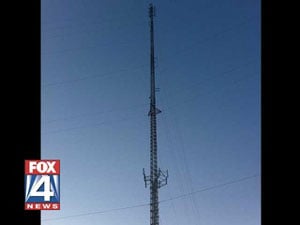 The Burleson (TX) Fire Department recently got a chance to put their skills (and stamina)to the test when they rescued a worker from atop a 750-ft cell tower. It sounds like they did a great job, and serves as an important reminder of the challenges these towers can pose to local emergency responders. Preplanning for this type of incident is critical – especially when it occurs in the middle of summer! Temperatures were 100+ degrees at the time of the dramatic rescue.
The Burleson (TX) Fire Department recently got a chance to put their skills (and stamina)to the test when they rescued a worker from atop a 750-ft cell tower. It sounds like they did a great job, and serves as an important reminder of the challenges these towers can pose to local emergency responders. Preplanning for this type of incident is critical – especially when it occurs in the middle of summer! Temperatures were 100+ degrees at the time of the dramatic rescue.
In situations like this, rescuers not only need the proper technical skills and equipment for a rescue of this intensity, but also adequate manning for such a physically demanding endeavor.
Hopefully, if faced with a situation like this, you will have personnel who are trained, equipped and physically able to deal with it. Fortunately, it was a great outcome for this team. However, let’s not miss the opportunity to learn from their experience and be prepared if we get this type of call!

 In this article, we want to provide some background on our experiences with users of rescue equipment, and why we feel proper training is so important. In the past 30 years, we’ve had the honor of having thousands of students attend our rescue training classes. Attitudes toward the statement “Do not use this equipment without proper training!” runs the gamut. It goes from “I never read the instructions,” to “I read, understand, and follow them to the T.” As our students come in all shapes, sizes, experience levels, attitudes, and needs, this is understandable. However, there’s one common denominator, they have come to us for training – and that’s our critical role.
In this article, we want to provide some background on our experiences with users of rescue equipment, and why we feel proper training is so important. In the past 30 years, we’ve had the honor of having thousands of students attend our rescue training classes. Attitudes toward the statement “Do not use this equipment without proper training!” runs the gamut. It goes from “I never read the instructions,” to “I read, understand, and follow them to the T.” As our students come in all shapes, sizes, experience levels, attitudes, and needs, this is understandable. However, there’s one common denominator, they have come to us for training – and that’s our critical role. FEMA and the FCC will conduct the first “nationwide” test of the Emergency Alert System (EAS) on Nov. 9 at 2 p.m. Eastern time. The test may last up to three and a half minutes, FEMA announced. The test will involve broadcast radio and television stations, cable TV, satellite radio and TV services, and wireline video service providers in all states and the territories of Puerto Rico, the U.S. Virgin Islands, and American Samoa. The two agencies said this test will help the federal partners and EAS participants determine the reliability of the system and its effectiveness at notifying the public of critical information that could save lives and protect property.
FEMA and the FCC will conduct the first “nationwide” test of the Emergency Alert System (EAS) on Nov. 9 at 2 p.m. Eastern time. The test may last up to three and a half minutes, FEMA announced. The test will involve broadcast radio and television stations, cable TV, satellite radio and TV services, and wireline video service providers in all states and the territories of Puerto Rico, the U.S. Virgin Islands, and American Samoa. The two agencies said this test will help the federal partners and EAS participants determine the reliability of the system and its effectiveness at notifying the public of critical information that could save lives and protect property. Valero Energy Corporation pledges “consistent, high-quality products” but its most important measure of success is the “health and safety of its employees, contractors, customers and neighbors.” So, it’s no surprise that Valero sends its rescue teams to the Roco Challenge. One Valero team member professed that while Roco’s Rescue Challenge was indeed “very challenging,” he also added that his team benefited from the communication, leadership, safety awareness, problem-solving experience and teamwork.
Valero Energy Corporation pledges “consistent, high-quality products” but its most important measure of success is the “health and safety of its employees, contractors, customers and neighbors.” So, it’s no surprise that Valero sends its rescue teams to the Roco Challenge. One Valero team member professed that while Roco’s Rescue Challenge was indeed “very challenging,” he also added that his team benefited from the communication, leadership, safety awareness, problem-solving experience and teamwork.



